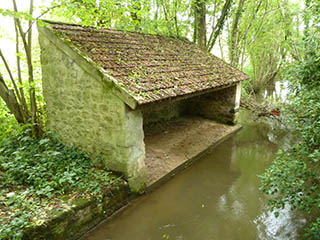Prochain point : lat="49.134968" lon="2.149871"

Wash House
When water dictated the pace of daily life
In the days when the Sausseron...
The Sausseron rises on the slopes of the Buttes de Rosne in the hamlet of Heurcourt in the municipality of Berville, where it is still a stream called the Soissonne. It only becomes the Sausseron at Margicourt (in the hamlet of Arronville) when it exits the Rabuais marshes. It then runs for about 22 kilometres with a vertical drop of 59 metres before flowing into the Oise at Valmondois. The river has a fairly constant flow rate with few seasonal fluctuations. The catchment covers an area of approximately 12,000 hectares in 22 municipalities, and is home to a wide variety of flora and fauna.
... fed several wash houses
The municipality of Labbeville had a number of wash houses: at the Maigniel farm (Rue de l’Ancienne Gare), Petit-Biard, near the source of the Cauchois (close to the old railway line) and at Sente de l’Abreuvoir. The latter is set in secluded forest and is powered by the mill race. It was built in the second half of the nineteenth century when the rural municipalities designed a hydraulic infrastructure to improve living conditions and the everyday lives of the inhabitants. The construction of public wash houses in France gained momentum with the Act of February 3, 1851, when the state began to cover up to 30% of the related masonry and carpentry work and pipelines.
The architecture of the Sente de l’Abreuvoir wash house was common in Vexin Français. The three sides are enclosed by high walls made of rough masonry with buttered joints and a slopping roof, thereby shielding the washerwomen from the weather. Access to the washing area was through a small opening in the rear wall.




